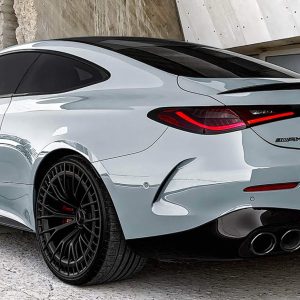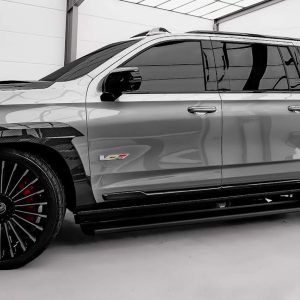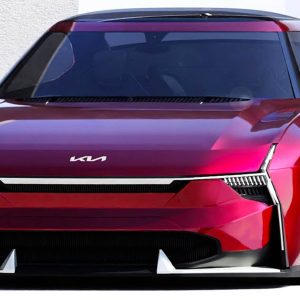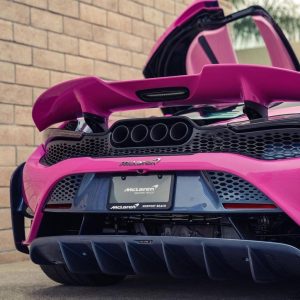
I promised myself I wouldn’t use the F-word in this review. However, the automaker responsible for some of the world’s best luxury cars insists that the word flagship applies to its Spartanburg, South Carolina-built 2023 BMW XM performance SUV. And after a brief test drive and quick glance at the spec sheet and price tag, it’s hard to disagree.
The all-new plug-in hybrid family hauler is BMW’s biggest and most powerful SUV yet, and it’s not afraid to show it. Unless you’re rolling quietly on EV mode, of course, in which it enjoys an estimated 30 miles of electric-only range. Otherwise, it boasts a heavy presence with dramatic styling that, for better or worse, sets it apart from the competition.


The Basics
The XM is the flagship SUV for several reasons: It’s BMW’s tallest vehicle but it also possesses the most horsepower and torque. It also serves as a proof-of-concept for the brand’s future plug-in hybrid technology and runs on the latest iDrive 8 infotainment system.
The exterior design of the XM is a love-it-or-hate-it situation. The vertically placed, upwards-tilted tailpipes are neat, and its side profile looks generally good for a muscular SUV. The kidney grille? Well, everyone has thoughts about it, but in the XM it is well integrated with contoured lighting that helps outline it and make it a big visual statement. I’m not sure it needed more defining, but BMW claims the overall styling is for more extroverted clientele. You probably could have guessed that.

The cabin offers more familiarity. The front seats are almost infinitely adjustable and are comfortable. In front of the driver sits a long, curved display that measures 12.3 inches and houses the instrument cluster. It also connects to the infotainment screen that clocks in at 14.9 inches diagonally. The steering wheel is comfortable and has oversized carbon fiber paddle shifters as well as BMW’s normal suite of front-facing buttons. Fitment is a bit awkward, however. Despite being highly adjustable, I couldn’t get the seat and steering wheel to fit me perfectly and had to compromise during my brief road test. Normally BMW gives you plenty of tilt in most of its new cars, but this was not the case in the XM.


BMW calls the backseat area the M Lounge, and while that’s cheesy, it’s accurate. The headliner has a swanky design etched into it with LED mood lighting outlining the edges. There are also two pillows plopped on the comfortable leather bench seat that come as standard equipment.
Under the hood is a 4.4-liter twin-turbo V8 paired with an eight-speed automatic transmission, onto which the electric motor is also integrated. BMW claims this “combined” powertrain resembles more its latest FIA LMDh prototype race car than anything else in its passenger car lineup. The V8 alone pumps out 483 horsepower and the electric motor can make 194 ponies, while the system’s max combined output is 644 hp according to BMW. This is apparently the latest revision of the hot-V 4.4-liter that first garnered acclaim in the F10 M5. So while it’s not necessarily entirely new, it has been changed and tuned appropriately to seamlessly work with the hybrid system.

Driving the 2023 BMW XM
Despite tipping the scale at 6,062 pounds, the XM handles its weight incredibly well. It can do zero to 60 mph in just 4.1 seconds and pull all the way to a 155-mph top speed (168 with the M Driver’s Package).
Launching this massive grizzly bear of an SUV is quite the experience. The all-wheel-drive system combined with an electronically locking M Sport differential grips and goes. And when it’s time to slow down and turn the wheel, the single-piston M Sport brakes and 275-front and 315-rear summer tires get the job done.
The XM can also handle itself in the corners. In the mountains between Prescott and Phoenix, Arizona, I hauled the heavyweight SUV at a decent speed on especially tight and twisty roads.
Set to either Sport or Sport Plus, the XM was composed through the corners. Its double-wishbone front and five-link fully independent rear suspension are fully adaptive and come as standard. Four-wheel steering helps mask its weight surprisingly well by offering extra-responsive turn-in, and active roll stabilization employs an electromechanical 48-volt system that actively engages and disengages the sway bars for the best balance of latitudinal control and comfort.
Rolling into a tight corner, braking hard, and transitioning back onto the throttle as soon as possible, while letting the M xDrive system and rear differential sort out optimum traction, was especially fun. The system felt engaging and never intrusive. It also never let things get too squirrely—just a light twitch followed by immense longitudinal Gs.
When you’re not blitzing mountain roads, the cabin is a chill place to be, isolated from the outside world with little wind noise to disturb the occupants. There’s more mood lightning up front, carbon fiber, and hard plastic surfaces throughout. The Bowers & Wilkins Diamond surround sound system features a 1,500-watt amplifier with four roof-mounted speakers and is hands-down one of the best stereo systems I’ve ever experienced.
Also, at 6 foot 3 inches, I had ample head, shoulder, and leg room in every seat—even the middle rear. The backseat behind my well-adjusted driver’s seat had plenty of legroom. As it tends to be in these large, high-riding vehicles, visibility out of the XM was good.
Settling down to more reasonable speeds and lighter inputs, the XM instantly became far more tame and compliant. Easy-going street and freeway driving presented an opportunity for battery-only propulsion. Its adaptability was fantastic.
BMW engineered the XM to have up to 30 miles of battery-only range, and it can cruise up to 87 mph while using the electric motor as its only power source. Hybrid is the default mode, however, and it will switch between modes up to certain speeds and throttle inputs. The system generally worked well, though the exception was setting off with heavy throttle inputs in Hybrid and Comfort modes; it would take a moment for the XM to switch from electric motor to internal combustion.
Price and Competition
The 2023 BMW XM is the brand’s first high-performance plug-in hybrid SUV. It starts at $159,995, which is a hefty sum for any vehicle, but also a solid deal compared to the likes of the Lamborghini Urus and Porsche Cayenne. The former starts at more than $230,000 while the Cayenne Turbo GT—the most comparable trim—starts $30,000 higher than the XM. When it comes to tech and hybrid propulsion, however, the BMW doesn’t have any direct competitors.

Value and Verdict
We might tug our collars at the styling today, but if consumers’ infatuation with large and excessive everything is any indication, BMW will probably sell every XM it builds. The Lamborghini Urus was considered visually too much, too bulky, and generally pompous when it debuted—yet it’s the brand’s best-selling model.
As far as walking the walk and talking the talk, the XM lives up to its flagship status. (There goes the F-word again!) It’s monumentally fast, handles exceptionally well for a car of its size, and has more grip than its looks lead you to believe. Perhaps more importantly, it represents a huge step forward for the luxury SUV in general, especially for those that retain the internal combustion engine as the primary means of propulsion.





